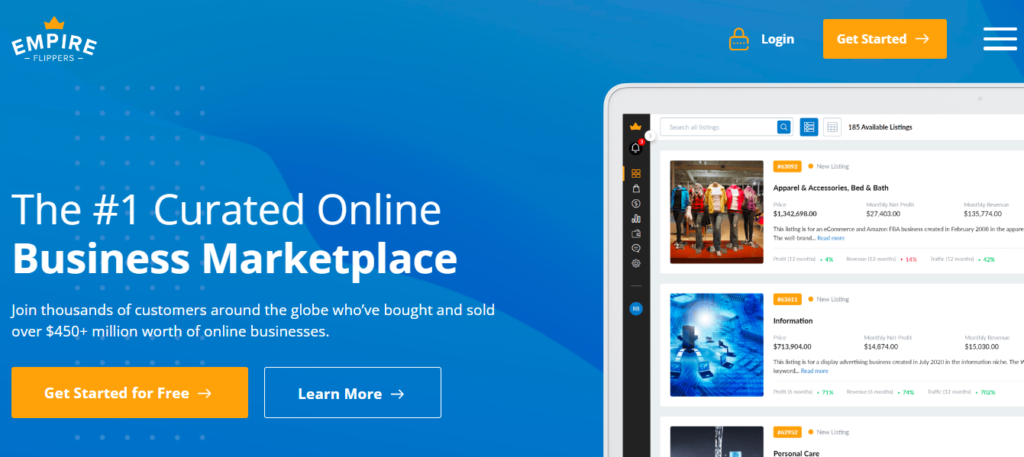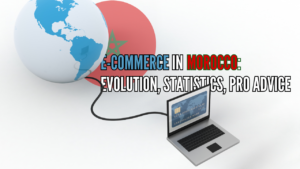
Selling a website can be a lucrative way to make money online. In fact, a site can be worth between 20 to 50 times its monthly net profit.
However, you might not achieve the maximum profit without meticulous planning and a well-structured timeline. It’s crucial to learn how to optimize it and understand what gives it value before finalizing a web transfer agreement to sell it and embark on a new online venture.
Introduction
In this article, we will present the five steps involved in selling a website. We will also review the factors that contribute to a website’s value and address frequently asked questions about the optimal time to sell a site.
How to sell a website in 5 steps?
If you’ve decided to sell your website, we recommend following a structured plan that will help you do so effectively and generate profits. Here are the five steps to follow when selling a website.
Step 1: Evaluate the website
Understanding the website’s value is crucial to avoid selling it below its market price. Similarly, an overly high price might discourage potential buyers.
The net profit is the total revenue minus operational costs such as hosting plans, domain name, marketing expenses, and employee salaries.
Apart from the average monthly profit, consider the multiple of your online activities. The multiple of a site includes valuable assets such as traffic sources, revenue streams, domain authority, business age, high-quality backlinks, and social media presence.
These factors are important as they inform buyers about the site’s long-term potential.
Important note! Generating low-quality backlinks and using a Private Blog Network (PBN) can decrease the multiple, potentially leading to search engine penalties for the site.
On website listings, you’ll notice the average multiple ranges between 20 and 50. The higher the multiple, the higher the selling price.
Consulting marketplace listings can provide insight into the value of various types of websites.
To better understand your website’s value, look for similar listings to gain a realistic idea of its worth. Consider reaching out to a website broker experienced in this field who can assist in drafting the sales contract.
Moreover, you can utilize free calculators to determine a site’s value, such as Empire Flippers valuation tool.

Step 2. Increase the site’s value
If the current value of the site is lower than anticipated, there are several measures you can still take to increase its value before putting it up for sale.
Optimize site performance
A slow-loading site can deter visitors. Therefore, optimizing the site’s performance is essential to increase its value. Here are some of the best strategies:
- Utilize a fast hosting service as it plays a critical role in the site’s performance.
- Implement a Content Delivery Network (CDN) to distribute content more rapidly.
- Choose a fast-loading theme or template. (scrowp theme for example)
- Remove outdated and unnecessary plugins as they can slow down the site’s speed and compromise its security.
Prepare a content strategy
Developing a high-quality content strategy will help enhance audience engagement and drive organic traffic, thereby improving the site’s search engine ranking and increasing its value.
Moreover, a content strategy will aid in maintaining consistent brand image and traffic when transferring the site to a new owner.
To consistently generate quality content, here are some questions to consider:
- Who is your target audience? What are their pain points?
- What type of content will you create?
- What content formats will you use?
- On which channels will you publish it?
- How frequently will you publish it?
Expand traffic sources
When aiming to increase a site’s value, relying on a single traffic source is not ideal. For instance, solely focusing on PPC campaigns.
Although using paid advertising can quickly generate traffic, depending solely on it suggests to potential buyers that substantial marketing spending might be necessary. The more customers you attract through paid advertising, the more money you spend.
Likewise, the traffic volume will likely decrease once you stop spending money on advertising. Hence, it’s essential to dedicate time to growing other sources, including organic traffic and referral traffic.
Referral traffic refers to users coming from other sites. One way to grow this is by guest writing articles for other sites related to your niche.
A steady flow of diversified traffic enhances a site’s value by providing a higher profit margin, better scalability, and long-term stability.
Experiment with various monetization strategies
A site with diversified revenue sources holds more value due to increased financial security. To diversify revenue sources, consider employing the following monetization strategies:
- Affiliate link sharing: Participate in affiliate marketing programs and earn a commission when visitors click on affiliate links and make a purchase.
- Use PPC advertising: Earn money each time a visitor clicks on an ad. Google AdSense is a popular tool for placing ads on a website.
- Accept guest posts: Allow other users to publish their content on your site for a fee.
- Sell digital products: Create and offer subscription-based content like online courses or eBooks.
- Add an ecommerce store: Sell goods or offer other products on the site.
Promote the website on social media
The presence of an audience signifies a strong brand and potential lead generation for the site. This is a valuable asset that can increase the selling price by bundling the website and its social media profiles.
To assess the value of profiles, visit sites like Social Tradia, focused on buying and selling Instagram accounts. Look into creators’ profiles within your niche to determine the best price.
If the accounts aren’t as valuable as expected, promote the site on social media by sharing relevant content and links directing the audience to the website. Use trending hashtags to increase message visibility and expand your audience.
Engage by responding to questions and comments from your followers. If budget allows, consider investing in paid advertising. However, remember this will increase site operational costs.
Grow your email list
Email marketing is a primary sales channel; 64% of small businesses use it to communicate with customers. It helps establish a connection with people interested in your online business and guides them through the customer journey.
Having a subscriber list demonstrates to potential buyers that the site has an engaged audience and an interference-free channel that can be monetized.
To collect new visitor information, utilize pop-ups and forms. For WordPress users, use contact form tools like OptinMonster or WPForms.
Then, send weekly newsletters, offer promotional codes, and provide useful content. Include links that lead them back to your website.
Also, add a call-to-action (CTA) in pop-ups and emails, using action verbs like “Learn More,” “Download Now,” and “Subscribe to Our Newsletter.” Choose a contrasting color to make the CTA stand out from the rest of the content.
Step 3. Find the right marketplace or broker
For those new to selling websites, especially if you aim to sell online independently, finding buyers can be challenging. Using a marketplace or engaging a broker can expose your online business to a larger pool of potential buyers, thus expediting the entire process.
There are numerous marketplaces and brokers available. Hence, it’s crucial to select a reputable marketplace that aligns with your website type and requirements. Among the most popular marketplaces are Flippa, Empire Flippers, and Motion Invest.
While some exclusively cater to ecommerce or content-based sites, others also include SaaS businesses and mobile services. Therefore, preliminary research on each marketplace and a thorough analysis of their terms of use are essential.
Here are some key factors to consider when seeking the right marketplace:
- Commission structure: Some marketplaces charge higher listing fees for lower-value sites and vice versa. Also, check whether they charge only listing fees or also take a commission after your site sells.
- Listing information: Generally, site sellers must provide data on traffic, revenue, and operational costs. It’s noteworthy that Empire Flippers hides the site’s URL, whereas Flippa does not.
- Communication methods: Examine how the marketplace facilitates communication with buyers, whether through public comments, private messaging, or scheduled calls.
- Escrow service: Check if the marketplace offers its own escrow service or requires you to use a third-party service to secure online transactions.
- Website migration: Verify if the marketplace facilitates site transfer and if it charges additional fees for this service. For instance, Empire Flippers offers a free migration service, while Flippa delegates this task to respective sellers and buyers.
- Due diligence: Determine whether you’ll need to conduct due diligence or if the marketplace assists you. This involves examining legal documents like the sales contract to ensure legitimacy for both sellers and buyers.
Step 4. Prepare financial and traffic reports
To persuade potential buyers, merely claiming significant growth potential for the site isn’t sufficient. As buyers seek evidence, backing these claims with data is crucial.
Well-structured financial and traffic reports contribute to establishing credibility and effectively communicating the site’s value.
Moreover, internet marketplace platforms and website brokers typically require sellers to submit an income statement and a traffic report for the listing. Verified buyers then gain read-only access to the statistics.
For traffic statistics, link your site to an internet analytics or search engine optimization tool such as Google Analytics, Semrush, or Ahrefs.
For instance, Google Analytics provides data on monthly page views, traffic sources, and traffic data based on channels or segments. It also indicates the number of unique visitors, growth rate, and countries attracting the most visitors.
With this data, buyers can identify site development opportunities and determine if its target market aligns with their needs.
The income statement details your business’s revenue and expenses for a specific period. Typically, most marketplaces and brokers require reports covering six to twelve months.
If the site has multiple revenue sources—such as earning from Google Ads and direct advertising—ensure to specify the amount generated by each source.
Moreover, state gross revenue and monthly profits. Remember to add your net margin, calculated by subtracting total expenses from generated revenue. Ideally, the monthly profit should exceed the expenses incurred.
Pro Tip: Remember, even a small error can create a negative impression and compromise your credibility. Hence, be meticulous when preparing an income statement.
For larger sites, it might be advisable to entrust this task to a professional accountant.
Step 5. Maximize profits before listing
Before listing an ecommerce site, for example, it’s best to reduce your involvement in online activities. While doing so, seek solutions to cut costs and maximize profits.
For day-to-day business operations, consider hiring a virtual assistant who charges businesses based on working hours.
Delegate content production by hiring reliable content writers and designers on freelance platforms like Upwork and Fiverr.
To ensure brand image consistency, create a style guide describing the current tone and voice of the content.
Additionally, if you manage an ecommerce store, consider using third-party services to handle order fulfillment and automate the business process.
Amazon FBA, ShipNetwork, and ShipBob are reputable order fulfillment services in the ecommerce realm.
Ensure that all necessary site-related data is transferable.
How to Determine Website Value?
Whether you plan to sell your own website or establish a website selling business, understanding how a website is evaluated is essential.
Determining the site’s value can assist in deciding whether to sell it or continue relying on its monthly income.
Here are some factors influencing its value:
Niche
A website’s niche is crucial as market demand helps determine the revenue it can generate.
A site in a popular niche is likely to receive more traffic, enabling you to sell it at a higher price.
Among the most profitable blog niches are food, personal finance, lifestyle, and travel. Food blogs alone generate a median income of $9,169 per month. For comparison, personal finance blogs yield $9,100 per month, while travel blogs average around $5,000 per month.
These evergreen niches have consistent demand throughout the year, thus likely to maintain traffic despite changing trends.
Visitor Count
The number of visitors a site attracts is another determinant of its value. Regardless of quality content and design, a site without visitors won’t attract buyers.
By generating traffic to your site, you increase prospects and enhance conversion rates. Leverage its market position for this purpose.
Analyzing traffic sources helps identify what works and what doesn’t. Besides quantity, traffic quality is crucial.
The site should attract visitors who can benefit from it and engage with it. To determine visitor engagement, assess parameters like average time on page, average pages per session, and bounce rate.
Use tracking tools like Ahrefs and Google Analytics to calculate the site’s traffic value.
SEO (Search Engine Optimization)
A site that effectively implements SEO strategies holds higher value as it indicates potential for organic traffic growth.
This involves high-quality content, quality backlink creation, and maintaining site performance.
Additionally, the site should be optimized for all devices since 60% of Google searches originate from mobile devices.
While increasing and maintaining organic traffic demand more time and effort, sites with good SEO are more valuable to potential buyers.
Revenue sources
Another factor determining a site’s value is the type of monetization it employs.
A site generating revenue from multiple sources will likely have a stronger selling point than those relying on a single income source.
For instance, if you have a food blog, instead of solely sharing Amazon affiliate links for kitchen utensils, earn revenue by displaying advertisements for a restaurant or offering a subscription-based cooking course.
Thus, if Amazon reduces its affiliate commission rates, you can still display ads on the website and sell digital products to generate income.
A website with diversified revenue sources benefits from financial stability and greater growth potential than those with a single income source.
Broker
If the process of evaluating a website seems confusing, engaging a broker might be helpful.
Website brokers are individuals or companies that sell websites. Besides evaluating the site’s value, they handle its marketing, negotiate prices with potential buyers, and conclude deals.
In exchange for their services, brokers typically charge clients a commission of 6 to 15% for each website sale. Therefore, consider this amount when calculating your website’s selling price.
Compared to independently selling your website, collaborating with a broker accelerates the selling process as they have access to a list of credible buyers. This minimizes the risk of encountering scams and making mistakes in legal documents.
Additionally, as they understand the site’s potential, brokers can help you avoid selling your site below its market value.
Marketplace
Some marketplaces work in partnership with brokers but also offer the option to independently list the site. Others function similarly to online auction sites like eBay.
Like brokers, marketplaces usually charge listing fees or success fees. Generally, these range between 5 and 15% of your site’s sale.
Websites are typically sold at a fixed price or follow an auction-style selling model. In the case of auctions, sellers set a minimum price, and buyers offering the highest price within 30 days can purchase the site.
In this scenario, although your site’s value also depends on bidders, it’s essential to set a price not significantly lower or higher than its market value.
Get a FREE business valuation
Conclusion
Selling your website to maximize profit requires careful planning and meticulous work. Before diving into this online activity, understanding the factors that influence a site’s market value will assist you in setting the right price and attracting buyers.
Keep in mind that investing time and effort in increasing a site’s value is crucial for a successful selling process. This includes expanding traffic sources, preparing a content strategy, and establishing a strong social media presence before finalizing a sales contract.
To quickly find buyers, consider using a marketplace or engaging a broker. Ensure thorough research into their terms and services, particularly regarding their commission structures.
Next, prepare financial reports and traffic analysis to demonstrate the site’s performance and growth potential.
Lastly, test various strategies to optimize profits and ensure the site is ready for transfer to a new owner. The less involved you are with the site as the transfer approaches, the smoother the process will be.
Now that you know how to sell your website, it’s time to evaluate your sites’ worth and plan the steps to enhance their value before putting them on the market. Wishing you the best of luck!
Further read : How to make money online like Warren Buffet?





